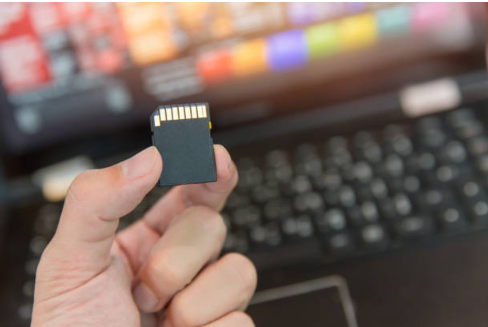How to Fix Your SD Card Not Showing Up on Windows 11/10/8/7
When you plug your SD card into your Windows computer, all your files are supposed to display in File Explorer. But your SD card is not showing up there. Why is that so, and how you can make your card accessible again, you’ll find this in this article. We’ll also give some tips to avoid the ‘SD card not showing up on Windows 11/10/8/7’ issue from cropping up again in the future.
Part 1: Common Reasons Why SD Card Is Not Showing Up
When your SD card is not showing up in Windows, it could be because of:
- The SD card might be half-inserted, or the slot may be dirty.
- Physical damage can stop the card from functioning.
- Removing the card without ejecting or sudden power loss.
- Some devices can’t read certain formats like NTFS.
- A damaged or old reader might not detect the card.
- The card’s lock switch is on.
- Old or corrupted drivers can stop the reader from functioning.
Part 2: Quick Checks Before Troubleshooting
Before you test out advanced solutions to troubleshoot the ‘Computer/laptop not recognizing SD card’ issue, here are some basic checks to perform:
-
Try Different Ports or Card Readers
Many times, the problem could be with the USB port or the card reader. Therefore, try plugging the reader into a different USB port, as some ports can stop functioning. If that doesn’t help, use another card reader, as yours might be faulty or not compatible with your SD card.
-
Try the Card on Another Device
To examine if the SD card is faulty, try it on another computer or your phone, or your camera. If it functions elsewhere, the ‘SD memory card not recognized’ issue is likely due to your original computer, not the card.
-
Check Device Manager or Disk Management
On Windows, if your SD card is not detected in PC File Explorer, check if it appears on Device Manager or Disk Management. A warning icon in the Device Manager means there might be a driver problem. While in Disk Management, if the card appears in the drive list on the left without a drive letter, you may need to assign one to it.
-
Reboot Your Computer
Sometimes, a quick restart can fix the ‘SD card not detected in PC’ issue. Thus, reboot your computer to refresh the system and remove temporary glitches.
Bonus Tip: How to Recover Files From an Unreadable SD Card?
Don’t apply any solutions to resolve the ‘SD card not showing up in File Explorer’ malfunction before extracting your data from it. This is because to fix the ‘SD card not showing up on Windows 11/10’ glitch, you might have to format the card, causing data loss.
Therefore, it’s imperative to use a specialized SD card recovery tool that functions on unreadable/inaccessible memory cards. Utilizing 4DDiG Data Recovery is on point here. This tool can extract data from micro, SDHC, SDXC, and standard memory cards with a 98.7% recovery rate. Here’s what more it offers:
- A GUI interface that’s friendly for both beginners and professionals.
- Can extract 2000+ types of files and allows preview of recovered files.
- It supports all popular SD card brands, e.g., SanDisk, Kingston, Lexar, etc.
- It offers a free trial for Windows users.
Here’s how to use this tool to recover files from an inaccessible SD card:
Step 1: Execute the SD card recovery tool on your computer. Connect your memory card as well. Choose it.
Step 2: Pick the file types to scan. Hit “Scan.” Once it finds the required files, stop or pause the scan.
Step 3: Hit “Recover” to export them either to your computer or cloud drive.
Part 3: 7 Proven Ways to Fix SD Card Not Showing Up on Windows 11/10/8/7
If the basic checks don’t resolve the ‘SD card not showing up’ glitch, here are 7 proven ways. Pick one based on whether your card appears in Disk Management or Device Manager or not:
Method 1: Update or Reinstall SD Card Drivers
When your SD card is not showing up in File Explorer but in Device Manager with a warning sign, its driver might be corrupted or need an update. Here’s how you can update or reinstall the driver:
Step 1: Connect the SD card to your computer for access. Right-click “Start.” Then, choose “Device Manager.” Double-tap “Disk drives” to extend it.
Step 2: Right-click the driver. Hit “Update driver.” Next, pick “Search automatically for updated driver software.”
Step 3: If there’s no update available, right-click the driver. Tap “Uninstall device.” Reboot your computer to automatically reinstall the driver.
Method 2: Assign or Change Drive Letter
In case your SD card is not detected in PC File Explorer but appears on Disk Management, it could be because of a drive letter conflict. Thus, assign a new letter or change the existing one on your memory card:
Step 1: Connect the SD card to your computer for access. Right-click “Start.” Then, choose “Disk Management.”
Step 2: Right-click the SD card. Then, select “Change Drive Letter and Paths.” Tap “Change.”
Step 3: Assign a new drive letter to the SD card. Hit “OK.”
Method 3: Run the CHKDSK Utility
Your memory card might have a corrupted file system, which could be why the SD card is not showing up in File Explorer but is appearing on Disk Management. You can run the Windows-embedded CHKDSK utility to repair the file system:
Step 1: Connect the SD card to your computer for access. Type “cmd” in the Windows search field.
Step 2: Then, execute “Command Prompt.” Input the following command. Hit “Enter” afterward:
- chkdsk [drive letter]: /f /r.
Method 4: Run a Virus Scan
Still no luck? This could be a sign of a virus. Malware can corrupt your card’s file system. However, you can run an anti-virus scan like Windows Defender to remove that virus:
Step 1: Connect the SD card to your computer for access. Input “Virus & threat protection” in the Windows search field.
Step 2: Choose “Scan options.” Opt for a “Full scan.” Hit “Scan now.”
Method 5: Reformat the SD Card
In a situation where your computer/laptop is not recognizing SD card because the virus has badly corrupted the file system, reformat the card. Here’s how to do that:
Step 1: Connect the SD card to your computer for access. Right-click the “Start” button. Then, choose “Disk Management.”
Step 2: Right-click the SD card. Tap “Format.” Pick a file system and adjust the volume label. Untick “Quick Format.” Hit “OK.”
Method 6: Enable the Card Reader in BIOS
When your SD memory card is not recognized in File Explorer and Disk Management, it might not be activated in System Setup (BIOS). To activate it:
Step 1: Restart PC. Hit the “Pause Break” key to stop the loading process instantly. Enter the BIOS setup by following the on-screen indications.
Step 2: Next, tap F1, F2, F8, or Del to enter BIOS. Use the arrow keys to move to either “Advanced,” “Onboard Devices,” or “Integrated Peripherals.”
Step 3: Hit “Enter.” Find the “USB Controller.” Use the + or – keys to adjust it to “Enabled.
Step 4: Press F10 to exit BIOS. Restart PC.
Method 7: Update Your OS
Windows update contains bug fixes and drivers for hardware components that might be missing from your system if it’s not updated. That’s why your SD card is not showing up in File Explorer or Disk Management. So, here’s what to do:
Step 1: Input “update” in the Windows search field. Tap “Check for updates.”
Step 2: Then, hit “Check for updates” again. Windows will find the latest drive updates for your SD card and install them.
Part 4: Tips to Avoid SD Card Detection Issues
Here are some tips to avoid the ‘computer/laptop not recognizing SD card’ issue from propping up in future again:
- Clean the metal contacts on the card from time to time.
- Format your SD card as FAT32 or exFAT, but avoid full formatting.
- Keep the card safe from heat, water, and pressure.
- Always use the “eject” option before removing the card.
- Keep your device’s firmware updated for better SD card support.
- Look for physical damage in the SD card slot.
- Backup periodically and always use card readers from reputable brands.
Bottom Line
If your SD memory card is not recognized on your Windows File Explorer or Disk Management, there are many ways to make it accessible again. However, before you apply any, use a tool like 4DDiG Data Recovery to extract your data from inaccessible/unreadable memory card lest you lose it.


